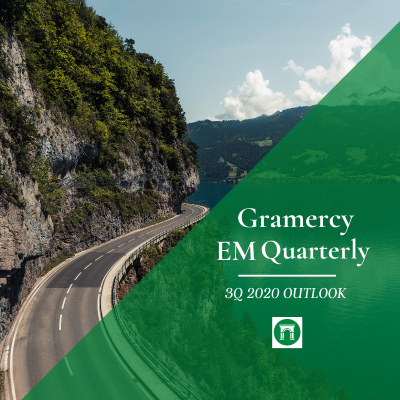Authored by:
- Robert Koenigsberger, Managing Partner & Chief Investment Officer
- Mohamed El-Erian, Senior Advisor
- Petar Atanasov, Senior Vice President & Co-Head of Sovereign Research
- Kathryn Exum, Senior Vice President & Co-Head of Sovereign Research
June 25, 2020
The Global Environment, Investment Themes and EM Asset Allocation
With some widely-monitored data releases for the U.S. economy surprising on the upside in terms of sharp improvements, particularly employment and retail sales, and with Europe embarking on its own economic re-opening process, financial markets have embraced and front-run the notion of a “V”-shaped economic recovery led by the advanced economies. The impulse provided to risk assets has been amplified by confidence in continued massive central banks support for markets – itself confirmed in recent weeks by continued activism on the part of the four most systemically important institutions in advanced economies (the Bank of England, the Bank of Japan, the European Central Bank and the Federal Reserve).
The optimism of markets contrasts not just with current realities on the ground, but also with the latest set of forecasts by international organizations, all of which have been revised to signal a more challenging global growth outlook. These include a very sharp second quarter drop in GDP that is unlikely to be fully offset by the end of next year. This also comes at a time of a notable increase of COVID-19 hospitalizations in certain U.S. states, as well as a second wave in China that has the government re-imposing lockdowns in part of Beijing.
The most significant worsening in COVID-19 health conditions has been in the developing world and, particularly, in Latin America which the WHO recently identified as the epicenter of COVID-19’s “third wave” globally. This increases the challenges facing emerging countries that, apart from some bounce in commodity prices, continue to face difficult external economic and financial conditions – including sluggish export demand, devastated tourist receipts, lower worker remittances and limited inflows of foreign capital investment.
The large and widening contrast between economic/health realities on the one hand and financial market reactions on the other is but one of the unusual uncertainties facing investors in the period ahead. They are amplified not just by economic consideration pertaining to uncertainties about globalization, productivity, payment behavior, growing supply side concentration and the return of robust consumer demand. The inequality trifecta (of income, wealth and opportunity) is likely to worsen, amplifying legitimate concerns about persistent social injustice (including racial discrimination). Geo-political tensions have also risen, regionally in Asia and between China and the United States.
Judged in terms of both favorable price behavior and of easy and relatively cheap access to new bond financing, sovereign and corporate investors have shrugged aside these uncertainties, underpinned by ample central bank driven liquidity (actual and expected). Having said that, investors have to consider how best to supplement shorter-term tactical considerations with longer-term strategic ones. In doing so, they find themselves navigating an unsettling journey that, at least as of now, is heading to quite an uncertain destination.
The complexity of the challenge is augmented by the fact that the destination itself is likely to be influenced significantly by the length of the journey, particularly when it comes to what is likely to be a (pendulum-like) iterative process of finding the appropriate balance between lives and livelihoods. These considerations weigh heavily on how best to balance what have been incredibly supportive market technicals with the more challenging outlook for corporate and sovereign fundamentals, particularly in developing countries.
Themes Influencing Investment Decisions in the Third Quarter.
Theme 1: Progression of the pandemic and the global economic outlook
Through various containment and mitigation measures during the second quarter, many countries around the world managed to slow down the exponential spread of COVID-19. As we enter 3Q20, the focus of the authorities in societies where the outbreak seems to be under control is shifting from “flattening the curve” to cautiously restarting economic activity while trying to avoid a second wave of the pandemic that would derail a nascent economic recovery from a low base.
There are a few notable exceptions where the confirmed new case curve is either still trending up or has not yet entered a strong downward trajectory: Brazil, Mexico, South Africa, Indonesia, and India among others. In the regions that have experienced the highest mortality rates, Western Europe and the U.S., new cases have been consistently trending down since early in the second quarter with certain pockets of exception. Africa is the continent that has been the least affected so far, while Latin America has turned into the latest epicenter of the pandemic as it progressed from East to West across the globe. Please see the most up-to-date information and critical trends in the Johns Hopkins COVID-19 Case Tracker.
On the economic front, 2Q20 was characterized by an unprecedented sudden stop in global economic activity reflecting the restrictions associated with “flattening the curve”. The economic costs inflicted by the crisis are set to be staggering and a number of major economies are expected to shrink by more than 30% quarter-on-quarter (QoQ) in 2Q, while in year-on-year (YoY) terms, the global economy will experience a far deeper contraction in 2020 compared to that during the Global Financial Crisis (GFC) of 2008-09 (please see Exhibit 1).
Exhibit 1: The global economy is experiencing the deepest decline in recent history.
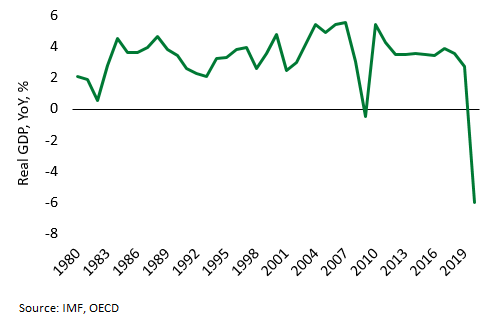
A sustainable medical solution to the crisis in the form of an effective and widely accessible vaccine is unlikely to be available until late 2020 at the very earliest, and the global community is still a long way from achieving “herd immunity”. As such, the economic outlook for the third quarter and beyond is shrouded in high uncertainty and hinges entirely on the notion of avoiding a re-acceleration of the outbreak. A “second wave” scenario would constitute a big blow to the nascent global economic recovery that we expect will start to take shape in 3Q as it could require re-imposing lockdown measures (albeit targeted ones), and, more importantly, will add to the many layers of uncertainty surrounding the global economy’s path going forward.
In the Organization for Economic Co-operation and Development’s (OECD) June Economic Outlook, they laid out two “equally probable” scenarios: i) a second wave of infections with renewed lock-downs hits before the end of 2020, and ii) another major outbreak is avoided. In the so-called “Single Hit” scenario, global GDP contracts by 6% YoY in 2020 before climbing back by 5.2% in 2021. In the more severe “Double Hit” scenario, economic activity falls by 7.6% YoY in 2020 and rebounds by just 2.8% YoY in 2021. Unlike during the height of the GFC when large emerging markets (“EM”) economies such as China, Indonesia, India, Poland and Colombia actually managed to deliver economic growth in 2009, the current shock is projected to have a significant recessionary impact on every major EM and developed market (“DM”) economy, including China (please see Exhibit 2).
On June 24th the IMF also released an update to its economic forecasts made in the April World Economic Outlook (WEO), in which the Fund projects a slightly less severe global growth contraction than the OECD, but still sees a deeper global recession and a slower recovery in 2021 than previously anticipated. The IMF projects that global GDP will decline by 4.9% in 2020, 1.9 percentage points lower than the April -3.0% forecast, followed by a partial recovery, with global growth projected at +5.4% in 2021 (0.4 lower than the +5.8% projected in April). The IMF downgraded its EM projections in line with global ones: -3.0% in 2020 (from -1.0% in April) and 5.9% recovery in 2021 (from 6.6% in April).
Exhibit 2: Unprecedented economic contraction across the board in EM and DM…
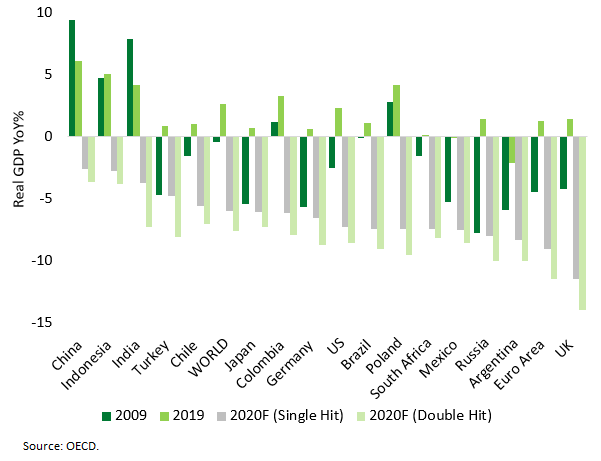
With the sudden stop in activity in many sectors, unemployment across most DM and EM economies has soared abruptly to levels significantly higher than those observed during the peak of the GFC (please see Exhibit 3). In the U.S. for example, the OECD projects unemployment of around 13% at the end of 2020, while the Federal Reserve sees it at 9-10%; both are multiples of the 3.7% pre-crisis level. A sizable share of displaced workers are unlikely to have their old jobs back even under a “Single Hit” scenario as companies scale back and entire industries might need to revamp their operating models in the post-pandemic environment. In that context, although most key macroeconomic variables have likely bottomed out in 2Q and we expect to see an improving trend during 3Q, the recovery of the real economy will be slow and bumpy. As such, in addition to any purely economic implications, the current crisis will also have long-lasting social effects.
Exhibit 3: …creating a negative feedback loop with soaring unemployment.
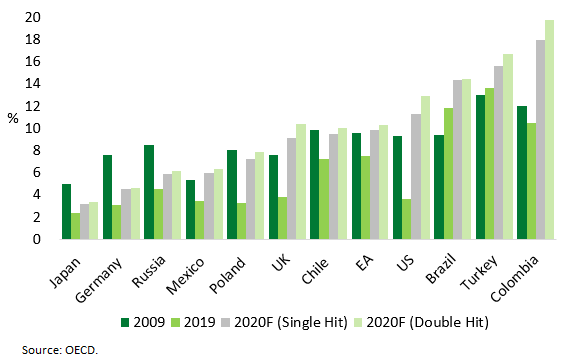
3Q20 will be a particularly challenging one for global markets to decipher. Forward-looking high frequency economic indicators such as PMIs (please see Exhibit 4) have rebounded in May from the extreme lows of April, but remain in contractionary territory. The one exception among major global economies is China where the PMIs bottomed out in February and returned to expansionary levels in May (54.5), reflecting the earlier exit of the Chinese economy versus the rest of the world from emergency measures against COVID-19. A confirmation of China’s economic recovery in upcoming PMI readings would send a more positive signal about EM growth, especially for commodity producers and other economies with material export exposure to China.
Exhibit 4: Global PMIs have rebounded; a firmer recovery hinges on avoiding a second wave of the pandemic.

Absent a second COVID-19 wave during 3Q, we expect high frequency economic data to continue improving due to societies re-opening and a very favorable base effect. On the other side of the scale, investors will have to weigh the journey to herd immunity, direct or through a vaccine, as well as the pandemic’s permanent/long-term impact to the global economic, social and political infrastructure, as clearer signals about the scope and scale of the damage continue to emerge during the upcoming quarter.
The notion that the improvement in macroeconomic data is from a “low base” is an important one. Exhibit 5 illustrates this point well. Given the depth of the contraction in the first half of 2020 and the forecasted gradual pace of recovery due to all the factors discussed above, even in a benign “no second wave” scenario global GDP will not return to late 2019 levels (i.e pre-crisis) for at least 2 years.
Exhibit 5: Global GDP will not recover to pre-pandemic levels for at least two years.
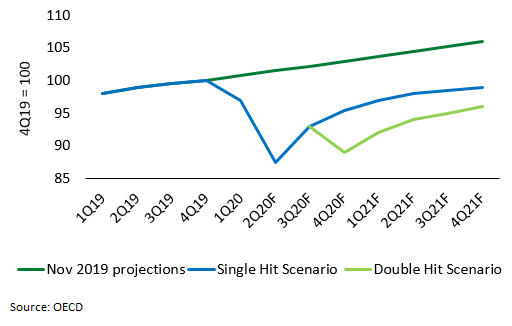
When thinking about the odds and implications of a “second wave”, we are concerned that preventing it could become increasingly challenging as social distancing measures are relaxed and the warm summer weather in the most heavily affected regions (Europe and North America) attracts people to venture outside of their homes and congregate in public spaces. In the event of a second wave scenario, we believe that any containment measures and restrictions are likely to be less draconian compared to the ones we witnessed in 2Q as governments and societies attempt to find a delicate
balance between public health and growing economic concerns. However, self-imposed isolation and social distancing will likely escalate dramatically should a deadly second wave of the disease materialize. This has the potential to elevate already high social pressures, especially in EM counties with large informal economies and weak or non-existing social safety nets. One thing is abundantly clear: a second COVID-19 wave before the end of 2020 will destroy any recovery momentum and postpone the tentative return to normal economic activity and eventual recovery.
Last, but not least, the outlook for growth and demand in the global economy is particularly important for oil and other commodity markets whose dynamics have a material credit impact over many EM issuers. After the capitulation in oil markets that took place in March due to the virus spreading beyond China, the price war between Saudi Arabia and Russia, and ETF financial market dislocations, oil has staged an impressive comeback in 2Q, alleviating fiscal and external pressures on oil-dependent sovereigns. Successive OPEC+ agreements on coordinated production cuts combined with the sharp decline in U.S. production is likely to support the market in the near-term. However, we expect shut-in production, especially in the U.S., which is down ~2.0 – 3.0 mb/d, to react to higher oil prices. In addition, the large global inventory balance and the return of Libya to the global stage should also cap a further recovery in the high $40s/bbl for Brent in 3Q20.
Theme 2: Policy backstops, fiscal space and EM debt sustainability
Against the backdrop of unprecedented uncertainty about the global economy’s trajectory and persistent major downside risks to growth and inflation, we expect the systemic global central banks to maintain ultra-loose monetary policy for quite a long time. Having learned lessons from the GFC episode, monetary authorities across the world economy acted decisively and in a large scale early on in the crisis and they have pretty much universally committed to “whatever it takes” measures going forward. In the event of a second wave of the virus before the end of 2020 and a “double hit” scenario for the global economy, the major central banks have signaled they stand ready to deploy “all of their tools, to the full extent, and for however long it takes” as Fed chairman Powell put it in a recent statement.
This being said, as we argued in our 2Q Outlook, steering the global economy back on the right track and especially cushioning the social fallout from the current crisis will require significant help from the fiscal side as well. This has materialized in a major way during 2Q as governments across the developed and emerging worlds unveiled various fiscal measures and programs. The size of fiscal support in DM has been extraordinary. Although smaller in relative terms, the programs implemented by EM authorities have also been robust, around 2-3% of GDP in direct fiscal stimulus on average across EM, with many countries in the 5-10% of GDP range.
We recognize that the large fiscal stimulus being deployed by EM governments is justified by the nature and size of the ongoing economic shock and provides a critical social backstop within their societies. However, we are growing increasingly concerned about fiscal and debt sustainability dynamics for certain EM sovereigns and their corporates, especially those that entered the crisis with already stretched credit metrics. Credit fundamentals will deteriorate across the board and we expect the notion of “resilience matters”, which we have been highlighting since late 2019, to be a theme EM credit markets increasingly focus on in 3Q and beyond.
The historically low interest rate environment globally is helping materially to alleviate debt sustainability pressures given the steadily growing government debt burden across EM. For 3Q, a continuation of the credit markets’ appetite for riskier assets shown in May and June on the back of the policy backstop and expectations that the pandemic has peaked could provide a window of opportunity for EM issuers to refinance short-term obligations and decrease liquidity risk. Despite the powerful mitigating factor of unprecedentedly low interest rates, as fiscal expenditures continue to increase sharply, fiscal revenues plummet and growth collapses, we still worry that the significant increase in EM debt burdens in 2020 (please see Exhibit 6) could push a few more sovereign balance sheets closer to a breaking point.
Exhibit 6: As fiscal stimulus unfolds and growth collapses, EM sovereign debt burdens will see material increases in 2020.
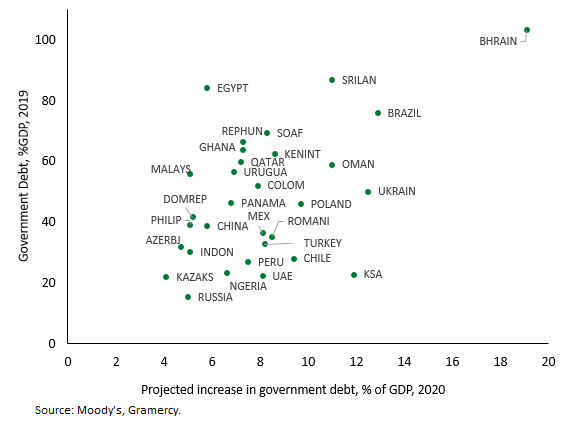
As far as markets are concerned, the availability of fiscal space and external buffers in the form of international reserves to cushion the economic shock caused by the pandemic should be the key credit quality differentiator for EM sovereigns in 3Q and beyond. Governments that entered the crisis with prudent fiscal policy frameworks and sizable buffers will have a clear advantage over their peers in terms of ability to absorb the economic and social shocks from the unprecedented sudden stop in economic activity and the likely slow recovery.
On the opposite side of the spectrum, the economic shock will crystalize the vulnerabilities of sovereigns with “pre-existing conditions,” especially in the form of stretched public finances and low international reserves relative to their economies’ short-term external obligations. As discussed above, many governments in this category are in the process of deploying a fiscal stimulus, in some cases quite sizable, given the extraordinary economic and social challenges that they are facing. However, in doing so they will be putting debt sustainability at risk and endangering their market access when conditions normalize.
The most vulnerable among the fiscally weaker sovereigns tend to be the ones that also face external (i.e. balance of payments) pressures such as economy-wide short-term liabilities (due within one year or sooner) that are large in relation of their FX reserves and as such, are subject to higher rollover/liquidity risk. Furthermore, some of these sovereigns, especially the ones that are not or have not recently been engaged with the IMF on a reform program, might be facing “broken economic models” that the authorities will need to start addressing once the most acute public health crisis period is over.
Theme 3: Shifting paradigms
As previously argued, the economic and investment landscape in the aftermath of the COVID-19 global health emergency will likely have a few key differences from the pre-crisis paradigm. They will be multi-faceted and evolving and will likely include higher debt and less fiscal space globally (see discussion above), deepened focus on resilience and protection of global supply chains which amplifies de-globalization efforts, a deeper entanglement of the state in the private sector and social and political implications which will likely shape future elections and policy. In the immediate near-term, we are seeing a risk of re-escalation of U.S.-China tensions in the run-up the U.S. election in November and especially if virus resurgence concerns fade.
Re-escalation of U.S.-China Tensions
U.S.-China tensions, which barely calmed following the Phase 1 trade deal in January, have reignited with the perceived peak in COVID-19 infections in the U.S. that has allowed key officials in the Trump Administration to refocus their attention back on China. Although we always expected the truce to be temporary, this recent escalation has been sharp, with a rapid deterioration in rhetoric and accusations from both sides. There is the potential for some material developments, as the Trump Administration and U.S. Congress have threatened sanctions and other measures in response to China’s initial mishandling of COVID-19 and refusal to allow external investigations. At the same time, the U.S. appears to be pursuing punitive measures against Beijing for its Hong Kong National Security Law, which has been widely criticized for further stripping the region of autonomy. While we believe the harshest measures will be avoided, some form of penalty is likely to be implemented. China for its part has threatened to retaliate against U.S. action with its own list of countermeasures.
The escalation is in the backdrop of upcoming U.S. Presidential Elections in November. A recent Pew poll found that nearly two thirds of Americans have a negative view of China and playing to a domestic audience could further incentivize politicians to ramp up pressure. Even a Biden victory is unlikely to bring substantial reprieve as he has recently criticized President Trump for being too soft on China. What differentiates the recent escalation in our view is the intensification of rhetoric and emotions on both sides, further turning the conflict into one of ideology and deepening mutual distrust. While there has not yet been irreversible damage done to relations, this movement towards nationalism on both sides does not bode well for further cooperation. This comes in the context of already complex issues including human rights, technology, intellectual property, national security, and finance. The repercussions of an intensifying U.S.-China “cold war” on the global economy has been well covered, with particularly significant impact on global trade and on countries connected to the global supply chain.
Social and Political Implications
COVID-19 and the resulting economic recession has the potential to spark social and political unrest in a number of jurisdictions across the globe. The IMF expects per capita income to contract in over 170 countries, but the pandemic will affect segments of the population unequally. Unfortunately, it is generally the lower income populations that will bear the brunt of job loss and medical resource shortages. These realities are likely to exacerbate existing social tensions with potentially disruptive consequences; they will require government policies that move from blanket to targeted support to help workers transit to new jobs and provide social protection to the most vulnerable.
EM is especially exposed to these dynamics, given large informal sectors in many jurisdictions and much weaker or in some cases non-existent social safety nets to cushion the blow. We have seen anti-lockdown protests across the emerging world, in India, Brazil, Lebanon, South Africa and Chile among others. Social unrest has the potential to further damage economic activity through its effect on the business environment and investment sentiment. Furthermore, there have already been direct political implications of the pandemic manifested in widespread election delays this year and authoritarian regimes using the opportunity to further consolidate power and/or limit dissent.
Impact on Global Supply Chains
The pandemic has disrupted how companies think about their supply sourcing and will likely have lasting impact on global supply chains. We expect corporates to move away from solely emphasizing efficiency and cost to placing greater priority on the diversification and flexibility of their supply bases. This message had begun to make headway in recent years as political uncertainties from Brexit to U.S.-China trade tensions threatened to disrupt the established way of doing business, but the pandemic will further cement the trend. Coronavirus hit China two months before the rest of the world and as it shuttered factories, businesses found themselves without critical components overnight. With this experience, production moving forward is unlikely to be as centralized in China. The shift should benefit other countries with strong manufacturing bases, such as Mexico and Vietnam for example, but also the relevant industries in developed markets as “on-shoring” becomes a stronger trend.
Similarly, investors will likely begin to incorporate more “resilience metrics” into analysis. On the governance side, this includes whether management takes an active approach to risk mitigation. From an operations angle, it will be important to assess whether companies have adequate visibility into production and external demand or are able to source critical components from multiple suppliers to hedge against political or natural disaster risk. In general, investors will likely be more conscious of downside potential and shocks that could affect large portions of the supply chain as well as how well companies can cope with such disruptions.
Optimal Asset Allocation within Emerging Markets in This Context
As we enter the 3Q20, our top down asset allocation is anchored once again in two objectives; capturing the upside that is present in the markets but doing so in a fashion that relies upon warranted risk management for preservation of capital. In order to capture the proper ROA (return on assets) we anchor our approach on ROA (resilience, optionality and agility). Our asset allocation seeks to both deliver on FOMO and to prepare us for the challenges we discussed earlier in this Quarterly Outlook by seeking resilience in turbulent times, optionality on multiple market outcomes and agility to pounce when asymmetric opportunities present themselves.
This year has proven the importance of dynamic asset allocation in EM. Over the past three quarters, we have relied upon an active approach to be defensive, offensive and now defensive again. In order to achieve our dual mandate we rely upon a barbell that looks similar to the one we discussed in our Q1 outlook.
On one end of the barbell, we are looking for higher-quality credit that can weather bouts of volatility and fundamental credit deterioration in the post-COVID-19 era. Highly secured, structured private credit remains high on our preferences when seeking higher quality credit. However, in the COVID-19 era, much of this lending will focus on rescue financing to permit SME in EM to over-come liquidity issues by pledging high quality, uncorrelated assets, to weather the storm. In private/rescue finance, investors are paid explicitly for illiquidity risk as opposed to being short the put on liquidity on “liquid” public securities that proved so painful in March of 2020. In private credit/capital solutions, we can enjoy the benefits of self-origination (preferred covenants and asset-backed structures) and we can gain more access to the real economy, solid balance sheets and robust collateral packages in absolute terms and relative to public credit bonds. We will continue to look to capture the arbitrage between private and public credit in EM as evidenced by the yield premiums in the low to mid-teens. Some factors we highlight:
* As a result of the unprecedented stimulus by the global systemic central banks and the resulting liquidity that now exists in the market, there is a clear distinction of the access to capital. Investment grade EM corporates and top tier high yield (“HY”) clients will continue to have access to the capital markets. Lesser HY names, private companies or smaller growth companies will likely be challenged to access the public markets. Thus, we believe that private credit providers will have a unique opportunity during this period to find very compelling risk reward financing transactions.
* Pre-COVID-19, we saw little competition in private credit, providing us the opportunity to secure terms that were attractive. Today, the marginal cross-over investor has retreated to their home market. As a result, we are seeing unique opportunities for (1) rescue financing, (2) development of our lending platforms across EM which create local presence, scale and barriers to entry, and (3) one-off private financing with outsized returns and significant downside protection through non-correlated collateral.
* EM, similar to global markets, will continue to face a volatile path to recovery. The benefit of private credit is that it is a bottom-up approach that can structure sufficient protection around asset value to create alpha for investors while providing the borrowers sufficient liquidity to create value for their enterprise.
* Our robust structures have held strongly during the current crisis and validate private credit as an absolute driver of returns and an important complement to EM credit portfolios.
* We have a number of prospective new platforms that we are analyzing and advancing with, which gives us confidence that we will meet our goal of having five operating lending platforms by 2022.
In our long-only EMD portfolios, as we enter Q320, we prefer Hard Currency (HC) vs Local Currency (LC) Debt. Due to the massive rally in local yields, LC is unattractive from a yield perspective and the volatile nature of FX is an unreliable source of return, especially given the very uncertain global growth trajectory as EMFX tends to be a highly growth-sensitive asset. At current spread levels, we prefer corporates over sovereigns as the former represents a more diverse and uncorrelated universe and should be less impacted by the “paradigm of non-payment” (see our report here) that is gaining momentum in certain EMD sovereigns. We have also seen large recoveries in distressed HY sovereigns (Argentina, Ecuador, Lebanon and Zambia), however, virtually the entire spread pick-up of HY sovereigns over corporates is still coming from these four credits. As such, we do not feel comfortable relying on a very small group of idiosyncratic credits to justify the attractiveness of HY sovereigns, which leads us to believe there is better risk/reward in certain HY corporates (please see Exhibit 7).
Exhibit 7: EM HY Corporates vs. HY Sovereigns Spreads
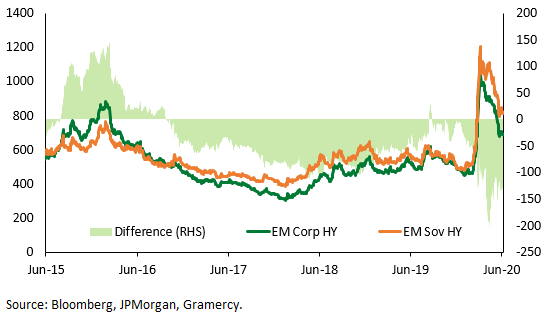
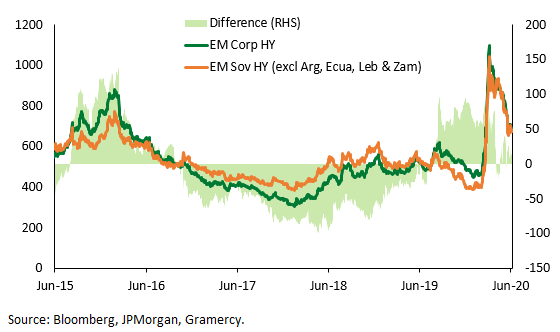
It is much more difficult today to make a broad call on investment grade (“IG”) vs HY. Fundamentally we have preferred IG as it has been in-line with our Top-Down view but after the massive rally in IG we are also relying upon more liquid, fundamentally sound HY credits to play the compression trade. By focusing on a combination of IG and better HY credits, we are able to participate in the rally but are not forced to take the credit risk of the names with higher default risk.
In our Alternative portfolios, as we entered Q2 we had just witnessed one of the largest and quickest dislocations over the past 25 years. Whereas the average dislocation in EM had taken 5 months to drop 20pct, in 2020 the market dislocated 20pct in less than 1 month. As a result, we significantly reduced the notional size of our at the money hedges and replaced them with further out of the money hedges. At the same time, we aggressively underwrote and methodically on-boarded higher quality credits that had been unduly impacted by the COVID-19-driven dislocation. The recovery from the dislocation was equally impressive, taking less than 3 months to recover ~20pct. (historically, the time to recovery has been 8 months on average, please see Exhibit 8).
Exhibit 8: Historical EM Drawdown Summary
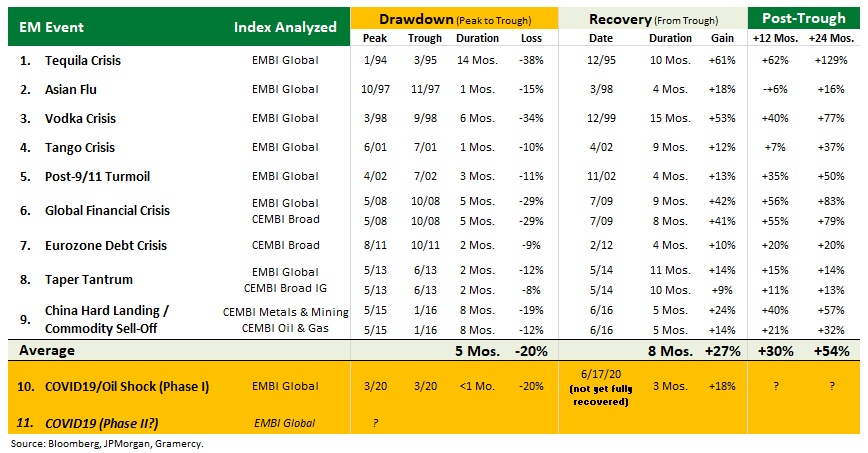
As we enter Q3 in our Alternative portfolios, we return to the posture we had at the beginning of the year. We are rotating back into a more robust hedge overlay and looking to increase the notional size and proximity to at the money hedges as the asymmetry in doing so presents itself. The same technical conditions that concerned us at the end of 2019 are present again at the halfway mark of 2020. We intend to use cheap asymmetric hedges to protect against the downside that could re-present itself due to dislocations, volatility and credit deterioration/paradigm of non-payment. CDS overlays and other beta hedges serve as life insurance for our portfolios that capture the once again decreasing premiums despite the increased risk of dislocations and credit deterioration (please see Exhibits 9 & 10).
Exhibit 9: EM Dislocation Recoveries
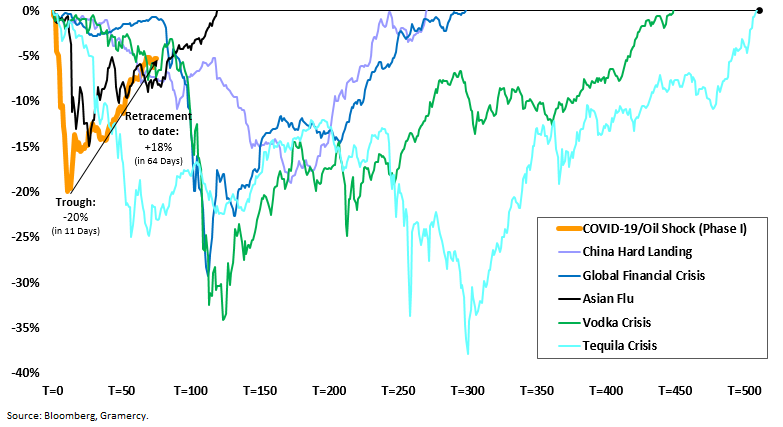
Exhibit 10: Historical Five Year CDS Spreads – Russia
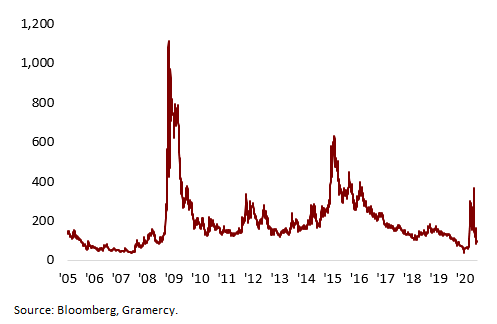
On the long side of the portfolios, we are actively underwriting dislocation candidates. We have now witnessed 10 major dislocations in the past 25 years that have resulted in meaningful drawdowns and powerful recoveries. With the tug of war between fundamentals and liquidity, we still anticipate bouts of illiquidity/dislocation driven by asset flows. We are identifying pipelines of distressed sovereign and corporate candidates that are highly likely to default in the post-COVID-19 era to anchor our EM Recovery theme. It is clear to us that debt sustainability for
many sovereigns and corporates will be increasingly challenged by deteriorating economic conditions, lack of market access and encouraged by the increasing paradigm of non-payment to default and restructure.
We have identified a list of sovereigns and corporates that entered this challenging period with “pre-existing conditions”. On the sovereign side, we are monitoring 35 EM countries that represent ~33% of EM GDP, some of which could need some form of debt forbearance or forgiveness as a result of large public deficits, weak balance sheets, and economy-wide short-term liabilities that are large relative to hard currency reserves. On the corporate side, we believe the EM HY default rate will surpass the 10.7% reached in 2009 (per J.P. Morgan) as a result of deteriorating fundamentals (higher leverage, lower profitability, higher capex spending) at the end of 2019, a wall of refinancing needs through 2022, and the pernicious combination of an oil price shock and global growth contraction. As a point of reference, the only two times over the last twenty years that the EM HY default rate reached double digits were in 2002 and 2009 when the preceding year exhibited a decelerating, but still positive, growth rate. For context, 2020 will undoubtedly see the worst global economic contraction since World War II, with EM regions heavily affected.
We do acknowledge that there are significant forces helping to prop-up the market in the short term, notably unprecedented monetary stimulus from developed market central banks (the Federal Reserve, European Central Bank, and the Bank of Japan have cumulatively increased their balance sheet by close to $8 trillion since the beginning of the COVID-19 crisis) which has enabled higher quality sovereigns and corporates to access the capital markets. That being said, we believe the aforementioned fundamental story in EM will ultimately rule the day and a wave of dislocation and distress is not a matter of “if” but “when”.
Given the massive size of the asset class and little demand/competition for distressed/defaulted assets in EM, we anticipate the opportunity set from the next distressed cycle in EM will rival anything we have seen over the past 25-plus years. We expect that defaulted assets that used to go from 100 to 40 and then recover to 65 (50-75% potential returns) will now trade much lower, perhaps 10-20 cents but then recover to 30-50 (2-3X MOIC) (please see Exhibit 11 for Asset Flow data).
Exhibit 11: Monthly and Annual Asset Flows into EM
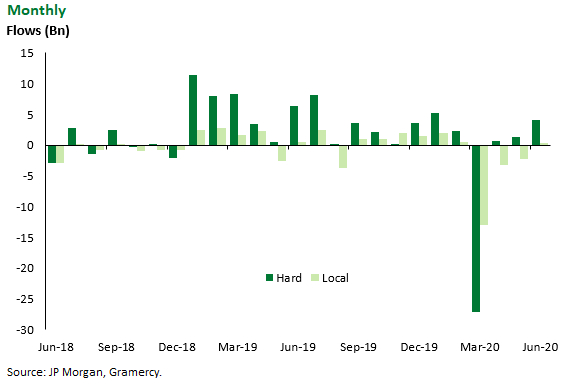
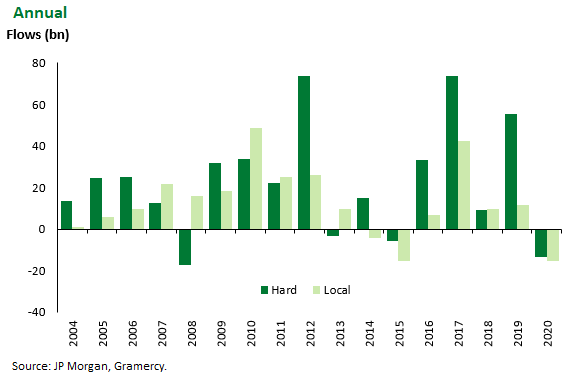
In Special Situations, we continue to pursue short-term lending opportunities related to COVID-19. These include government secured PPE purchases and financing business interruption claims. We also continue to provide litigation finance and collection on sovereign and corporate claims globally. Lastly, we are litigating and settling property insurance claims related to hurricane damage in Puerto Rico and Florida and looking to pursue a broader insurance claim recovery effort in the coming quarters. Special Situations investments remain attractive on both an absolute return basis and as an important diversifier in our multi-asset portfolios.
Perhaps a bit cliché, but the world has never been so uncertain. Now more than ever there are more unknowns than knowns. As such, now is not the time to express high conviction risks when high conviction is hard to obtain. Now more than ever we will seek to ensure that we make no non-recoverable mistakes. For us that means we are willing to miss part of the rally, particularly as it relies upon riskier securities to drive returns and ensure we don’t take unwarranted illiquidity/credit risk by stretching for yield. As always, we will remain disciplined and Plan the Trade and Trade the Plan.
About Gramercy
Gramercy is a dedicated emerging markets investment manager based in Greenwich, CT with offices in London and Buenos Aires. Our Mission is to positively impact the well-being of our clients, portfolio investments and team members. The firm, founded in 1998, seeks to provide investors with superior risk-adjusted returns through a comprehensive approach to emerging markets supported by a transparent and robust institutional platform. Gramercy offers both alternative and long-only strategies across emerging markets asset classes including capital solutions, private credit, distressed debt, USD and local currency debt, high yield/corporate debt, and special situations. Gramercy is a Registered Investment Adviser with the SEC and a Signatory of the Principles for Responsible Investment (UNPRI). Gramercy Ltd, an affiliate, is registered with the FCA.
Contact Information:
Gramercy Funds Management LLC
20 Dayton Ave
Greenwich, CT 06830
Phone: +1 203 552 1900
www.gramercy.com
Joe Griffin
Managing Director, Business Development
+1 203 552 1928
[email protected]
Investor Relations
[email protected]
This document is for informational purposes only, is not intended for public use or distribution and is for the sole use of the recipient. It is not intended as an offer or solicitation for the purchase or sale of any financial instruments or any investment interest in any fund or as an official confirmation of any transaction. The information contained herein, including all market prices, data and other information, are not warranted as to completeness or accuracy and are subject to change without notice at the sole and absolute discretion of Gramercy. This material is not intended to provide and should not be relied upon for accounting, tax, legal advice or investment recommendations. Certain statements made in this presentation are forward-looking and are subject to risks and uncertainties. The forward-looking statements made are based on our beliefs, assumptions and expectations of future performance, taking into account information currently available to us. Actual results could differ materially from the forward-looking statements made in this presentation. When we use the words “believe,” “expect,” “anticipate,” “plan,” “will,” “intend” or other similar expressions, we are identifying forward-looking statements. These statements are based on information available to Gramercy as of the date hereof; and Gramercy’s actual results or actions could differ materially from those stated or implied, due to risks and uncertainties associated with its business. Past performance is not necessarily indicative of future results. This presentation is strictly confidential and may not be reproduced or redistributed, in whole or in part, in any form or by any means. © 2020 Gramercy Funds Management LLC. All rights reserved.
